 |
|
|
| Date |
Information |
|
| 12/10/2017 |
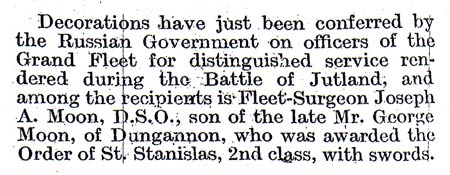 |
| 12/10/2017 |
From the Tyrone Courier dated 7th June 1917: (brother of George Moon) |
| 12/10/2017 |
Decorations have just been conferred by the Russian Government on officers of the Grand Fleet for distinguished service rendered during the Battle of Jutland, and among the recipients is Fleet Surgeon Joseph A Moon D.S.O., son of the late Mr George Moon, of Dungannon, who was awarded the Order of St Stanislaus, 2nd class, with swords. |
| 07/02/2017 |
Amongst the officers decorated by the King at the investiture on board a battleship during his visit to the fleet were Fleet Surgeon Joseph A Moon (Dungannon) and Staff Surgeon James McA Holmes (Islandmagee and Belfast), each of whom received the D.S.O. from His Majesty. |
| 07/02/2017 |
 |
| 07/02/2017 |
From the Belfast Newsletter dated 29th June 1917: (brother of George Moon) |
| 02/02/2017 |
The CWGC record Surgeon George Bassett Moon as the son of D. George Davis and Mrs Moon of 103 Uttoxeter New Road, Derby, England. |
| 02/02/2017 |
Fleet Surgeon Joseph A Moon, D.S.O., son of the late Mr George Moon, of Dungannon, is awarded the Order of St Stanislaus, 2nd class, with swords. He was educated at Dungannon Royal School. |
| 02/02/2017 |
 |
| 02/02/2017 |
From the Belfast Newsletter dated 6th June 1917: (brother of George Moon) |
| 10/12/2016 |
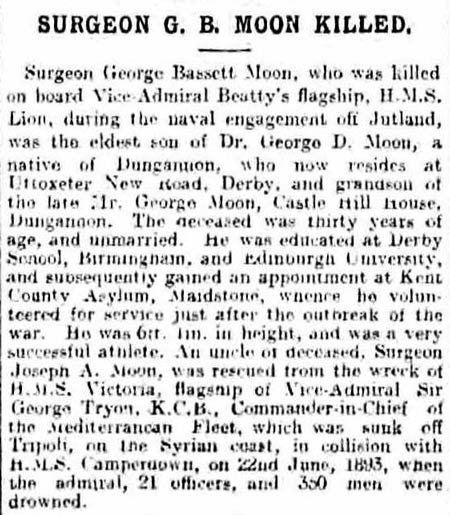 |
| 10/12/2016 |
From the Belfast Newsletter dated 19th June 1916: Surgeon G B Moon killed |
| 10/12/2016 |
Surgeon George Bassett Moon, who was killed on board Vice Admiral Beatty’s flagship, H.M.S. Lion, during the naval engagement off Jutland, was the eldest son of Dr George D Moon, a native of Dungannon, who now resides at Uttoxeter New Road, Derby, and grandson of the late Mr George Moon, Castle Hill House, Dungannon. The deceased officer was thirty years of age and unmarried. He was educated at Derby School, Birmingham, and Edinburgh University, and subsequently gained an appointment at Kent County Asylum, Maidstone, whence volunteered for service at the outbreak of the war. He was 6ft 1in in height, and was a very successful athlete. An uncle of the deceased, Surgeon Joseph A Moon, was rescued from the wreck of H.M.S. Victoria, flagship of Vice Admiral George Tryon K.C.B., Commander in Chief of the Mediterranean Fleet, which was sunk off Tripoli, on the Syrian coast, in collision with H.M.S. Camperdown, on 22nd June 1893, when the admiral, 21 officers, and 350 men were drowned. |
| 30/12/2015 |
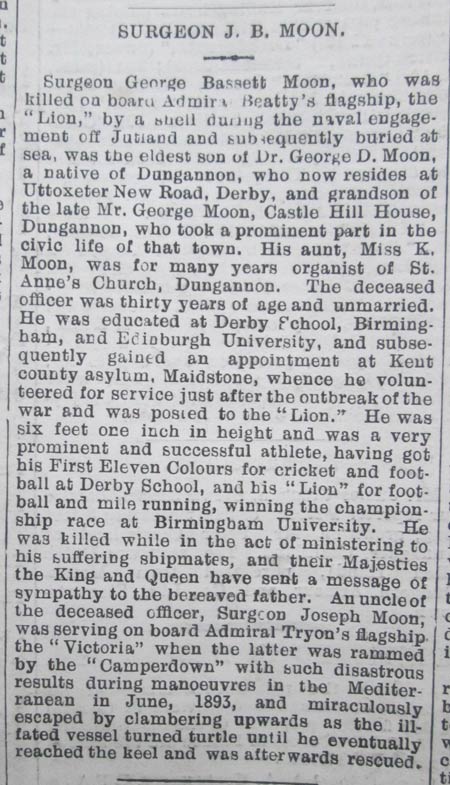 |
| 30/12/2015 |
George Bassett Moon was killed in this action in the Battle of Jutland on 31st May 1916, aged 30 years old. |
| 30/12/2015 |
George Bassett Moon was the son of Dr. George Davis and Mrs Moon, of 103, Uttoxeter New Rd., Derby. |
| 30/12/2015 |
George Moon was educated at Derby School and at Birmingham and Edinburgh Universities. |
| 30/12/2015 |
He was an enthusiastic cricketer and footballer and he played occasionally with the Derby County Reserve team at football, whilst at cricket he assisted the Friars and other local clubs. |
| 30/12/2015 |
At the outbreak of war, he was employed as assistant medical officer at the Kent County Asylum, Maidstone, before offering his services to the Admiralty. |
| 30/12/2015 |
George Bassett Moon joined the Royal Navy and served as Surgeon on board H.M.S. Lion. |
| 30/12/2015 |
HMS Lion was a battlecruiser of the Royal Navy, the lead ship of her class, which were nicknamed the "Splendid Cats". They were significant improvements over their predecessors of the Indefatigable class in terms of speed, armament and armour. The Lion-class ships were 2 knots faster, exchanged the 12-inch guns of the older ships for the same number of 13.5-inch guns, and had a waterline belt 9 inches thick versus the 6 inches (152 mm) of the Indefatigables. This was in response to the first German battlecruisers, the Moltke class, which were very much larger and more powerful than the first British battlecruisers, the Invincible class. |
| 30/12/2015 |
On 31 May 1916 Lion was the flagship of Admiral Beatty's Battle cruiser Fleet which had put to sea to intercept a sortie by the High Seas Fleet into the North Sea. The British were able to decode the German radio messages and left their bases before the Germans put to sea. Hipper's battle cruisers spotted the Battle cruiser Fleet to their west at 3:20 pm, but Beatty's ships did not spot the Germans to their east until 3:30. The range had grown too far for accurate shooting so Beatty altered course four points to port to close the range again between 4:12 and 4:15. This resulted in Lion hitting Lützow again at 4:14, but Lützow hit Lion several times in return shortly afterwards. The smoke and haze from these hits caused Lützow to lose sight of Lion, and she switched her fire to Queen Mary at 4:16. By 4:25 the range was down to 14,400 yards (13,200 m), and Beatty turned two points to starboard to open the range again. However. HMS Lion was hit twice more, during what came to be called the 'Run to the North', after the German battle cruisers made their own turn north. |
| 30/12/2015 |
“With main and secondary armament in action the German salvoes were being delivered about every twenty seconds, and our ships too were in a forest of waterspouts. It was one of the hottest moments of the action, when every nerve had to be strained to the utmost, and Admiral Beatty, having the enemy well abaft his beam, signalled to the 13th Flotilla that it seemed a good opportunity to attack. Five minutes later, while the fight still raged at its hottest, the Lion received a nearly fatal blow. A heavy shell struck Q-turret, entered the gun-house, burst over the left gun, and killed nearly the whole of the guns' crews, and it was only the presence of mind and devotion of the officer of the turret, Major F. J. W. Harvey, R.M.L.I., when almost incapacitated with a mortal wound, that saved the flagship from sudden destruction” |
| 30/12/2015 |
Extract from the Official History; " Naval Operations" by Sir Julian S. Corbett. 1923. |
| 30/12/2015 |
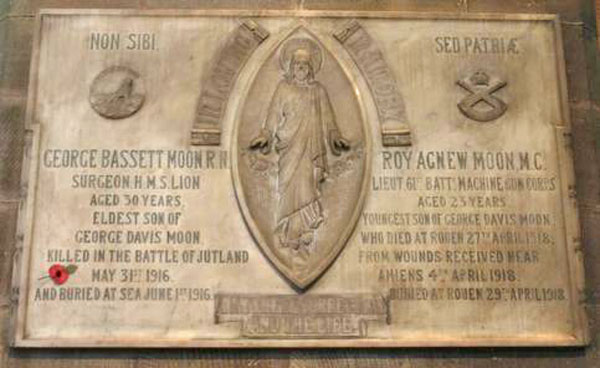 |
| 30/12/2015 |
George Bassett Moon and his brother Lieutenant Roy Agnew Moon (M.C.) are remembered on a Private Memorial to the Moon brothers erected inside St. Luke's Church, Derby. George is also commemorated on the Parish First World War memorial wall tablet in the Church. |
| 30/12/2015 |
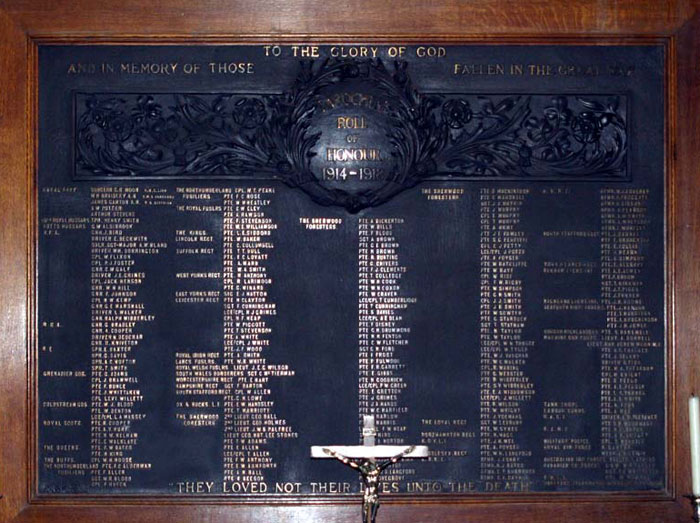 |
| 30/12/2015 |
 |
| 30/12/2015 |
From the Tyrone Courier dated 22 June 1916 |
| 30/12/2015 |
 |
| 30/12/2015 |
 |
| 30/12/2015 |
From the Mid Ulster Mail dated Saturday 24th June 1916: Surgeon J B Moon |
| 30/12/2015 |
Surgeon George Bassett Moon, who was killed on board Admiral Beatty's flagship, the Lion, by a shell during the naval engagement off Jutland and subsequently buried at sea, was the eldest son of Dr George D Moon, a native of Dungannon, who now resides in Uttoxeter New Road, Derby, and grandson of the late Mr George Moon, Castle Hill House, Dungannon, who took a prominent part in the civic life of that town. His aunt, Miss K Moon, was for many years organist of St Anne's Church Dungannon. The deceased officer was 30 years of age and unmarried. He was educated at Derby School, Birmingham, and Edinburgh University, and subsequently gained an appointment at Kent County Asylum, Maidstone, whence volunteered for service at the outbreak of the war. He was 6ft 1in in height and was a very prominent and successful athlete, having got his First Eleven Colours for cricket and football at Derby School, and his 'Lion' for football and mile running, winning the championship race at Birmingham University. He was killed while in the act of ministering to his suffering shipmates, and their Majesties the King and Queen have sent a message of sympathy to the bereaved father. An uncle of the deceased officer, Surgeon Joseph Moon, was serving on board Admiral Tryon's flagship, the Victoria, when the latter was rammed by the Camperdown, with such disastrous results during manoeuvres in the Mediterranean in June 1893, and miraculously escaped by clambering upwards as the ill-fated vessel turned turtle until he eventually reached the keel and was afterwards rescued. |
| 30/12/2015 |
From the Mid Ulster Mail dated Saturday 23rd September 1916: (brother of George Moon) |
| 30/12/2015 |
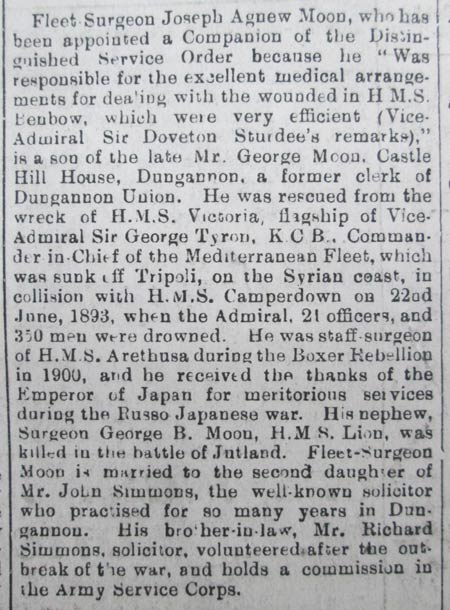 |
| 30/12/2015 |
Fleet Surgeon Joseph Agnew Moon, who has been appointed a Companion of the Distinguished Service Order because he 'was responsible for the excellent medical arrangements for dealing with the wounded in H.M.S. Benbow, which were very efficient' (Vice-Admiral Sir Doveton Sturdee's remarks), is a son of the late George Moon, Castle Hill House, Dungannon, a former clerk of Dungannon Union. He was rescued from the wreck of H.M.S. Victoria, flagship of Vice-Admiral Sir George Tyron, K.C.B., Commander in Chief of the Mediterranean Fleet, which was sunk off Tripoli, on the Syrian coast, in collision with H.M.S. Camperdown on 22nd June 1893, when the Admiral, 21 officers and 350 men were drowned. He was staff surgeon of H.M.S. Arethusa during the Boxer Rebellion in 1900, and he received the thanks of the Emperor of Japan for meritorious services during the Russo Japanese war. His nephew, Surgeon W B Moon, H.M.S. Lion, was killed in the Battle of Jutland. Fleet-Surgeon Moon is married to the second daughter of Mr John Simmons, the well-known solicitor who practised for so many years in Dungannon. His brother-in-law, Mr Richard Simmons, solicitor, volunteered after the outbreak of war and holds a commission in the Army Service Corps. |
| 30/12/2015 |
Surgeon George Bassett Moon, who was killed on board Admiral Beatty's flagship, the Lion, by a shell during the naval engagement off Jutland, was the eldest son of Dr George D Moon, a native of Dungannon, who now resides in Derby, and grandson of the late Mr George Moon, Castle Hill House, Dungannon. The deceased officer was 30 years of age and unmarried. He held an appointment at Kent County Asylum, Maidstone, and volunteered for service at the outbreak of the war. He was 6ft 1in in height and a prominent athlete. An uncle of the deceased officer, Surgeon Joseph Moon, also a Dungannon man, was serving on board Admiral Tryon's flagship, the Victoria, when the latter was rammed by the Camperdown, and miraculously escaped by clambering upwards as the ill-fated vessel slowly turned turtle until he eventually reached the keel and was afterwards rescued. |

|
|